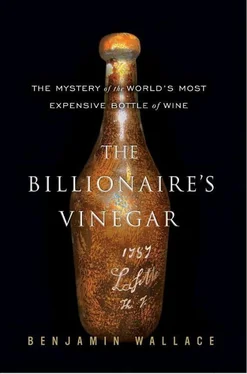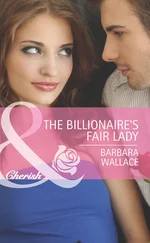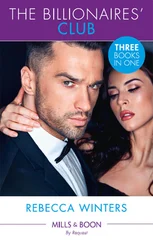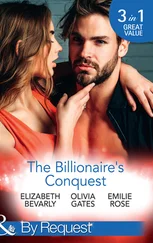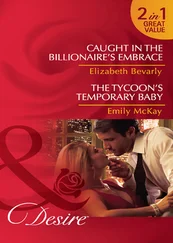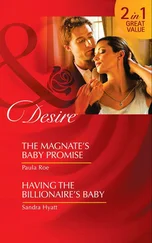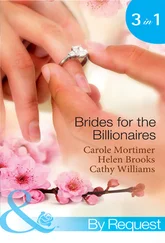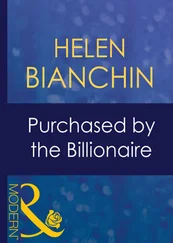There remained a number of relics that Monticello had located but had not been able to obtain, and many more that Monticello knew about but couldn’t locate. Monticello had never been able to find, for instance, a slew of paintings from Jefferson’s art collection that had been referenced in Jefferson’s documents. Every so often one would turn up, usually in as serendipitous a fashion as Rodenstock’s wine bottles. In 1912 a Jefferson-owned portrait of Thomas Paine turned up in a box of objects at a Massachusetts auction; the owner had no idea of its venerable history, which wouldn’t be recognized until the 1950s.
When it came to Jefferson’s wine, no bottles had ever been found. America’s early presidents had no entertaining budget, and Jefferson, in his first year of office, spent $2,800 of his $25,000 salary on wine. This kind of extravagance increased his already sizable debts, and he could no longer afford to keep deep stocks of wine. When Jefferson died, the 586 bottles left in his cellar held only wines from southern France and some Scuppernong.
In the 1960s, Monticello set about re-creating the wine cellar as it must have looked originally. It had been empty since Jefferson’s death. In February 1966 the curator of Monticello traveled to London seeking empty eighteenth-century bottles. He was able to find about twenty, and sailed back to New York with the plan of making molds to produce additional facsimiles. The closest Monticello came to laying hands on an actual artifact of Jefferson’s wine drinking was the discovery, in the course of archaeological digs begun at Monticello in the late 1970s, of most of a Madeira decanter and a shard of glass bearing the seal of Lafite.
IN 1985, CINDER Goodwin had her work cut out for her. Wine cherishes celebrities, and there are celebrities, certainly, who cherish wine. Nonetheless, celebrities loom much larger in the history of wine than wine does in their personal histories. While Thomas Jefferson was the foremost connoisseur of the eighteenth century, the fact received almost no mention in his biographies. The Monticello library’s file on Jefferson and wine was only an inch and a half thick.
But having spent much of the past five years doing the footnotes for the Memorandum Books, Goodwin had read countless Jefferson letters and was by now an old hand with Jefferson documents. Starting as a young man, Jefferson had kept several different diaries (one about his garden, one about his farm, one about his travels), every letter he received, a copy of each of the 16,000-odd letters he wrote in his lifetime, a correspondence log noting each letter sent and received, and the Memorandum Books. These last contained a daily record of every expenditure and every receipt of Jefferson’s from the age of twenty-four. There were bills for the oats for Jefferson’s horse in Paris. He also kept reams of miscellaneous accounts, which included customs records that accompanied the wine shipments he received in Paris. Jefferson larded his correspondence, to a tedious degree, with the minutiae of his wine orders, from shifting exchange rates to intricate freight-forwarding logistics. At his death, several tens of thousands of pages in his handwriting were in circulation.
“He didn’t have a wastebasket,” Goodwin said later.
It was more than this thoroughness that made her confident. Jefferson’s wine orders showed up in four different parts of the Jefferson record: the Memorandum Books, the miscellaneous accounts, the letters, and the letter log. Not in one or the other of them; most orders could be found in all four. Jefferson not only wrote everything down; he wrote it down several times in several places. Of course, Jefferson was human, and maybe a particular letter had been misplaced, or an entry hadn’t been made; but some trace of the entry or letter would invariably show up elsewhere. “He was a hero of meticulousness,” in Goodwin’s words. Jefferson himself stated that he would swear on his deathbed to the reliability of the Memorandum Books, which he said had excluded only a single transaction in fifteen years.
This thorough, meticulous, and multiply redundant record had survived nearly intact. If the bottles found in Paris had indeed belonged to Jefferson, there was every reason to expect that supporting documentary evidence could be found. Goodwin called the Princeton letters project and spoke with Monticello’s curators, who confirmed that none of the wine bottles exhumed by archaeologists at Monticello had been engraved. Then she began scouring the written record.
Goodwin found that for the 1784 vintage, Jefferson had recorded the purchase of only two of the four wines found by Rodenstock: the Margaux and Yquem, which he had received in 1787 and 1788, respectively. In his 1788 letter to the owner of Lafite, Jefferson had ordered the 1784 vintage, but he was informed that none was available. As for 1787, the vintage of the Lafite that the Forbes family had just bought, there was no evidence that Jefferson had ever ordered, or even wanted to order, a 1787 Lafite or, for that matter, a 1787 anything. Nor was there any indication that he had received them without ordering them. In 1790, after his return to America, he did place one order for Yquem in which he didn’t specify vintage (he asked to be sent whichever was drinking best), but he had it shipped directly from Bordeaux to America, and he recorded that he received the shipment. And there was no record of his having ever ordered Branne-Mouton in any vintage.
On December 12, 1985, a week after the record-setting auction, Goodwin issued her report. She couldn’t just come out and say she thought Broadbent and Rodenstock didn’t know what they were talking about, so she began by flattering them: “When we learned that [Hardy Rodenstock and Michael Broadbent] were men of unquestioned knowledge and integrity, we began to reassess the possibilities of authenticity.” Then she methodically proceeded to establish that they didn’t know what they were talking about.
While Goodwin’s report focused on the record-setting 1787 Lafite, she made the point that the bottles must fall or stand as a group. They had been found together and engraved similarly, which must have happened after they left their respective châteaux. Given that Jefferson, from 1787 on, ordered his wine directly from châteaux, deliberately bypassing merchants, this meant either that one of his intermediaries in Bordeaux had done the engraving, or that they had been engraved after reaching Jefferson in Paris.
“He seems to have made the connection between the bottles and Jefferson by a study of the records,” Goodwin wrote of Rodenstock, “but it is precisely those records which make such a connection less and less likely.”
Broadbent, in his Christie’s-catalog provenance for the 1787 Lafite, had pointed to Jefferson’s 1790 order, which included a request that the bottles be etiquettés, or labeled, as support for the engraving. Goodwin pointed out that to engrave the entire shipment (1,020 bottles) would have been costly and would certainly have merited mention in Jefferson’s Memorandum Books, yet no such expense appeared there. Goodwin also homed in on the particular style of initials used. Jefferson had requested that the wine be marked “T.I.” In other circumstances he had used a cursive “TJ” to identify certain possessions, and “Th:J,” with a colon, to sign some correspondence. The form of the initials on the Rodenstock bottles was “Th.J.,” which Jefferson had never used or specified.
Goodwin further noted that Jefferson had requested that the marking take place at the vineyard, which didn’t explain how wines from four different vineyards seemed to have been engraved by the same hand. And she cited some letters that seemed to indicate that, by etiquetté, Jefferson had meant that the cases, not the bottles, be labeled. Most damningly, it seemed, the 1790 order had consisted only of Yquem and a lesser-known Bordeaux named Rausan. Not only had the shipment for Jefferson arrived successfully in America; even if the unspecified Yquem was 1787, the shipment had not included Lafite, Margaux, or Branne-Mouton.
Читать дальше
